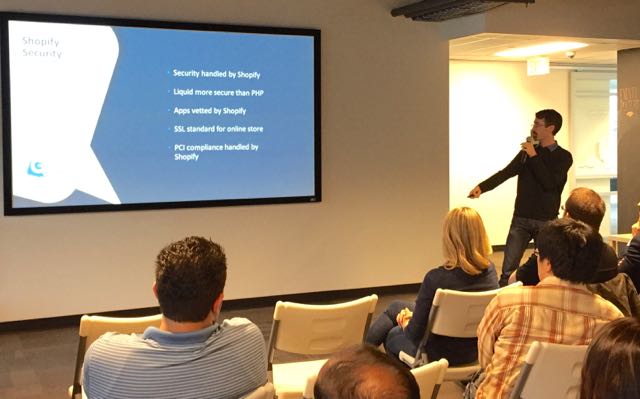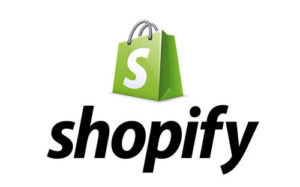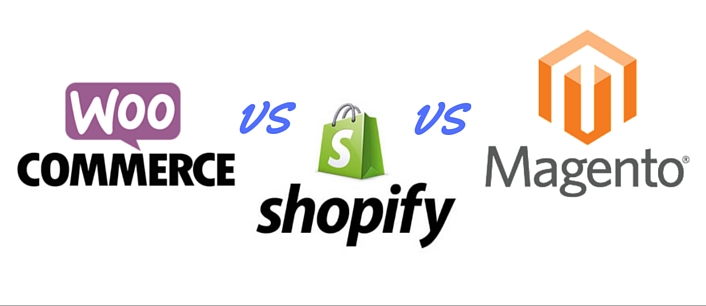So, you’re selling products and you think you’d like to take your business online. Make sales on the Internet. Engage in ecommerce. Get rich!
But how exactly are you going to set up an online store? What considerations do you need to make? What options do you have?
Those were the topics at a recent gathering of the Vancouver Web Design Meetup titled E-Commerce Shootout where the top three platforms were discussed: Woocommerce vs Shopify vs Magento.
The Meetup was sponsored by Vancouver’s Graphically Speaking and the presenters were all employees of that company.
Here’s what they had to say.
E-commerce tips
Presented by Andrew Rossdale, senior web strategist
For any ecommerce project look at your ROI for every item on your wish list. Make sure any improvement is worth the money.
Expect unknowns and prepare for change.

Be agile by building iteratively in smaller chunks and phases, and plan for change.
Have a requirements gallery. Decide what is custom and what is native to the platform. Keep systems that are designed in. Stick to requirements and not just solutions.
User Stories are good for use-case scenarios. Decide the Why for every requirement and include the reason for each requirement. Ask yourself if something can be put off to phase II.
Step back and look at all the moving parts to make sure it all works together
Have SMART goals for your project: Specific–Measurable–Attainable–Realistic–Timely
Plan for the roles you need to launch an ecommerce site: strategist, designer, project manger, front-end programmer, back end programmer, content production specialist, and digital marketer.
Your product data sheet should include title, price, in stock, colors, and at least 3 pictures. Specs might include a pdf, and assets can be in a table format.
Don’t be dead set on the platform until the requirements are completed.
 WooCommerce
WooCommerce
Presented by Brittany Russo, project manager
WooCommerce is a free plugin for WordPress that adds an ecommerce function. It occupies 30% of the market share with 1 million current installs.
WooCommerce is made for businesses using WordPress who want to make easy updates on content-heavy sites.
WooCommerce is a light-duty system and can’t handle more than 50 SKUs. It’s compatible with most premium themes, or custom themes depending on budget. WP/Woo allows for advanced shipping options.
Because WooCommerce is open source using php, HTML, javascript, and CSS languages, it’s universal enough to allow you to switch programmers. It’s very flexible for customization.
Best of all, no licensing fees for WooCommerce, making it comparatively inexpensive. Maintenance is important for security reasons.
Security
You need to have a SSL certificate (https) which costs $150-300 per year, sold by your host or a 3rd party. The site must be PCI compliant. Payment Card Industry (PCI) is a data card standard to which you must comply or be fined.
Security requires plugins like iThemes, strong passwords, and limited logins, which is standard WordPress procedure but more crucial since transactions are involved.
Hosting
Shared hosting is ok, but don’t get the cheapest
You must have a fixed IP address, SSL, and the server must be warranted for PCI.
For more traffic, use Cloud VPS, deluxe shared host for $50-700 month
Support
It’s mostly DIY for advice
Theme and plugin authors offer some help
Check theme and plugin reviews before installing
[twocol_one]
WooCommerce Pros
Cheap and flexible
Familiar to users
Huge community
[/twocol_one]
[twocol_one_last]
WooCommerce Cons
Performance is slow on cheap hosts
Hard to scale, so keep under 50 SKUs
Security is more problematic for credits cards
[/twocol_one_last]
 Shopify
Shopify
Presented by Eoin O’Dwyer, senior front-end developer
Shopify is a stand-alone shopping cart platform, a Software-as-a-Service (SAAS). All you have to do is sign up to be hosted on the Shopify servers.
A simple online store works out of box without thinking too much.
Shopify has a flat hierarchy, not deep a hierarchy that allows drilling down into subcategories. Products are filtered by tags, but organized in a shallow way.
Shopify themes can be customized or created on your own if you are programmer. It uses Liquid markup instead of php, and is based on Ruby, with conditional logic. That makes it more secure and hard to run hacking scripts.
Shopify has a large app store for plugins like reviews, chat, etc. Basic apps are free, but you can pay for more sophisticated ones.
Pricing
$29- 179 per month hosted on their server.
Transaction fees 2.4%- 3.5% .30 per credit card transaction on Shopify’s gateway. Or, fees run .5 – 2% for external gateways.
Security
More secure. Strong password is all you need.
Liquid is more secure than php, being a smaller target for hackers
SSL iss included in Subscription
PCI is handled by Shopify
Point of sale is built in. Can be used in real store using iPad, card reader
Support is great. A smaller community, with more hands on from the company. Live chat, 24/7 phone. Email and documentation.
Shopify is for simple, small stores that are not complex. Lauching a site will cost a few thousand – $10k.
[twocol_one]
Shopify Pros
More ease of use over Woo
More secure for non-programmers
24/7 support
Fulfills all ecommerce requirements
[/twocol_one]
[twocol_one_last]
Shopify Cons
More difficult to customize than Woo
Harder to scale due to subcategory hierarchy
Not good for content heavy sites
A cart site only
[/twocol_one_last]
 Magento
Magento
Presented by Jason Keenan, senior systems analyst and technical manager
Magneto has 2 versions: Free and Enterprise.
The enterprise software is used by big companies.
[Think: Nike, Ghirardelli, Sierra Nevada, Flor, Oneida, Olympus, Rosetta Stone and Radio Flyer.]
Magento is a huge system made for dedicated infrastructures. The enterprise version is super expensive.
According to web tracker Alexa Internet, Magento is used on 25-30% of the top million sites.
Magento is fully customizable, controllable, and the software passes PCI audits.
It’s pricey. Enterprise licenses start at $30K per year. Spending $50k – $100-200k is not uncommon. Each license has dedicated support.
Hosting
A dedicated server is required and that runs $300-500 per month up to $1200 month for managed service. Or use the Magneto hosting called Application-as-a-Service (AAS).
PCI
The entry level PCI from Trustwave scanning service is $750 per year just to scan the site, and does not include a PCI audit.
Maintenance
For any software, you need to fund maintenance. Figure 20-30% of sales per year should go for maintenance costs, upgrades, patching, CDN check ups, plugins licenses, etc.
Target Market
While the other platforms target mostly Business-to-Business (B2B), Magento works for B2B and Business-to-Community (B2C) in all industries and markets.
For B2B, sales reps can use Magento offline, including its advanced search/order database.
For B2C, it’s good for omni-channel stock checking and micro warehousing.
Magento is great for:
- Multilingual
- Multi currencies
- Multi stores, brands
- Multi pricing
- Global accessibility
- Elastic scalability
- Special software integrations
- Business customizations
[twocol_one]
Magento Pros
Totally flexible
Massive community support
Largest ecommerce platform
Fortune 500 grade
Largest install base
Huge number of plugins
[/twocol_one]
[twocol_one_last]
Magento Cons
Major company structural considerations
Very expensive to launch and maintain
Requires experienced programmers to launch
Requires professional maintenance
Requires lots of time to set up
[/twocol_one_last]
WooCommerce vs Shopify vs Magento
So far, I’ve only used WooCommerce and can say it’s a fantastic and intuitive system. But Shopify is looking more and more intriguing for the right client. I wouldn’t even begin to think I could handle Magento, but perhaps you could.
If you’ve had experience working on these platforms, let us know what you think in the comments below.
And, if you live in the Vancouver area and want to learn about how to manage SEO on your site, please join us on July 11th at Big Rock Brewery for a special WordPress Workshop Meetup with Daniel Moscovitch who’s coming all the way from Israel to give us some professional tips. Please RSVP now!


WooCommerce is not limited to 50 SKUs. It can handle thousands.
Thanks Robert. That may be true. The number 50 was the recommendation of Brittany Russo at Graphically Speaking, so perhaps that was her experience on a content heavy site.